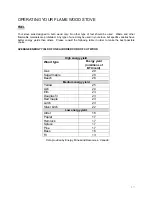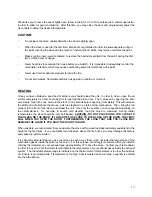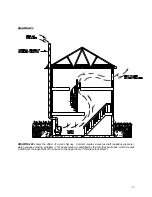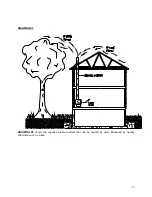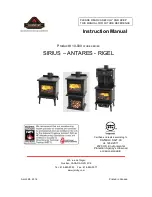
18
It is
EXTREMELY IMPORTANT
that you only use
DRY WOOD
in your wood stove. The wood must have
dried for 9 to 15 months, so that the humidity content is reduced below 20% of the weight of the log. It is very
important to keep in mind that even if the wood has been cut for one, two or even more years, it is not
necessarily dry, especially if it has been stored in poor conditions. Under extreme conditions, it may even
have rotten instead of drying. This point cannot be overstressed enough; the vast majority of the problems
related to the operation of a wood stove is caused by the fact that the wood used was too damp or had dried
in poor conditions. These problems can be:
- Ignition
problems.
-
Creosote build-up causing chimney fires.
-
Low energy yield.
-
Blackened glass door.
-
Incomplete log combustion.
Smaller pieces of wood will dry faster. All logs exceeding 6" (152 mm) should be split. The wood should be
stored in a place where the grass is not too long, in such a way that prevailing winds may circulate through
the fire logs. A 24" to 48" (610 mm to 1219 mm) air space should be left between each row of fire logs,
which should be placed in the sunniest location possible. If the wood must be stored outside, the upper layer
of wood should be protected from rain and bad weather but not the sides.
Before your first fire:
-
Check if firebricks are lined-up properly.
-
If applicable, remove the plastic protector covering the gold trims.
-
Make sure that the chimney and flue pipe are well installed according to specifications.
-
Respect all clearances to combustibles and floor protection according to the unit you have chosen.
-
If you are not sure that your installation is adequate, do not hesitate to contact your Flame dealer.
IGNITION
The installation of a log cradle is
NOT RECOMMENDED
in your
FLAME
wood stove.
After making sure that the stove air intake controls are fully open, place several rumpled sheets of paper at
the center of the firebox. Place 8 to 10 pieces of small dry kindling wood over the paper in the form of a tent.
You may also place a few pieces of firewood, but choose them as small as possible. No chemical product
(or accelerant) should be used to light the fire.
Before igniting the paper and kindling wood, it is recommended that you warm up the chimney. This is done
in order to avoid backdraft problems often due to negative pressure in the house; cold air from the outside
tends to penetrate into the house by the chimney and creates a “clog” effect.
If such is the case, open a window slightly near the stove and twist together a few sheets of newspaper into a
torch. Light up this paper torch and hold it as close as possible to the mouth of the pipe inside the firebox to
warm up the chimney. Once the updraft movement is initiated, you are ready to ignite the stove by lighting
the paper and kindling wood inside the combustion chamber.














